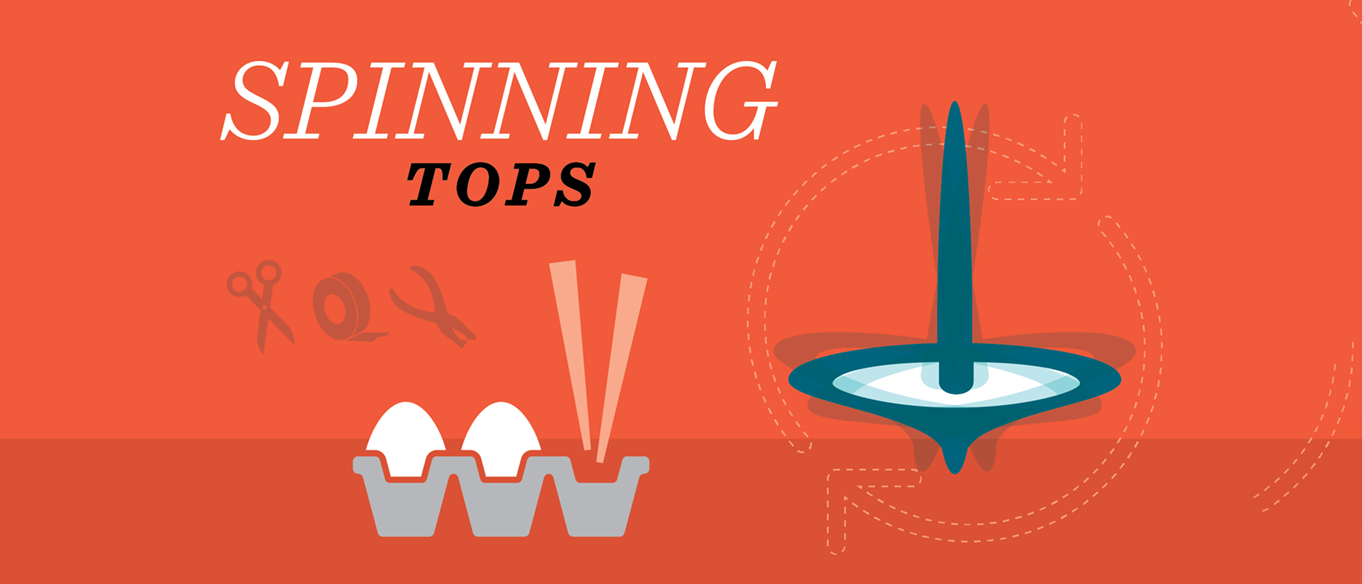
What does it take to make a spinning top? Find out in this engineering challenge as you design, build, and test spinning tops made from everyday items.
Age: 7+
Time: 20-30 minutes
Topics: rotation, center of mass, engineering design process
What you need:
- A variety of building materials, such as:
- Egg cartons
- Lids from disposable plastic food containers
- Cardboard, card stock, cereal or snack boxes
- Plastic water or soda bottles
- Bottle caps
- Plastic eggs
- Corks
- Rubber bands
- Pipe cleaners
- Paper clips
- Small binder clips
- Chopsticks or pencils
- Tools for working with the materials, such as:
- Scissors
- Hole punch
- Tape
- Paper and pencil for sketching ideas
- Stopwatch or timer
What to do:
1. Do some research. Have you ever played with a spinning top toy before? Think about other things you have seen that spin or rotate. What do they look like? What are they made of? How do you make them spin? Find photos online or in books of tops or other spinning objects to give you some ideas.
2. Now look over the building materials you collected. What types of materials might work best for designing a spinning top? Think about what shapes or parts of the items you might want to use; for example: a circle cut from cardboard, just one cup of an egg carton, or just the cone-shaped top of a soda bottle. Take a few minutes to brainstorm ideas for what your top could look like and sketch them on paper before you build.
3. Time to build your first design! Ask an adult if you need help cutting stiffer items like plastic or thick cardboard.
4. Test your design by timing how long it spins before stopping or falling over. Try to get the top to spin for at least 10 seconds.
5. If it doesn’t work, here are a few things to try as you rebuild and test again:
- Before you spin it, try to balance it on your finger. Does the weight feel equally balanced, or does it tip more easily to one side than the others?
- If it’s not well balanced, what could you do to help balance the weight?
- Could you use a different material to attach the pieces (for example, paper clips instead of tape)?
- Go back and look at the pictures of other spinning top toys. What are some things they have in common?
6. Keep rebuilding and retesting your design until you have a top that can spin for at least 10 seconds. If you achieve that goal, try for 20 or 30 seconds! Things to think and talk about:
- What do you notice about how fast your top spins?
- How well is it balanced?
- What factors other than the shape of the top might be affecting how it spins?
7. Reflect on your design process as a spinning top engineer. Ask questions like:
- How did your first design compare to your final design?
- How many iterations (versions or tries) did you make?
- Can you think of other supplies you don’t have that might make it better?
- Which parts of the top do you think are most important? What makes you think that?
8. Other ideas to try:
- Test your top five or ten times (or even more) and write down how long it spins each time. What is the longest spin time? What is the shortest? What is the average spin time?
- Create a new design that uses as few parts or pieces as possible.
- Create two or three different designs and compare them. Which spins the longest? Which is the heaviest? Which one is the most fun to watch?
What’s Happening?
Spinning tops can be made out of all different kinds of materials such as clay, wood, ceramic, or plastic. Most tops are made up of four basic parts: the tip or point, the crown, the shoulder, and the body. The top spins on its tip or point. At the opposite end of the top is the crown. The crown is often the part you hold with your fingers to spin the top. Below the crown is the shoulder. Everything between the shoulder and the point is the body.
The physics of a spinning top is complicated but depends on these three properties:
- Center of mass is the spot on an object where all the weight (mass) of the object is equally distributed. Objects balance best when their center of mass is directly above or below whatever is holding them up.
- Angular velocity measures how fast an object is rotating or spinning.
- Torque is the twisting force that causes rotation. You provide torque with your hands or fingers when you start a top spinning.
When designing new toys, engineers use the engineering design process:
- Research – Find out what other people have already made or discovered related to the item.
- Gather requirements – List all the things the new item needs to have, be, or do in order to work correctly.
- Brainstorm and plan – think of lots of different design ideas and then choose the best one.
- Build and test – make a first version of the item and test it.
- Redesign and retest – keep changing, testing, and improving the design until it meets all the requirements as well as it possibly can.

